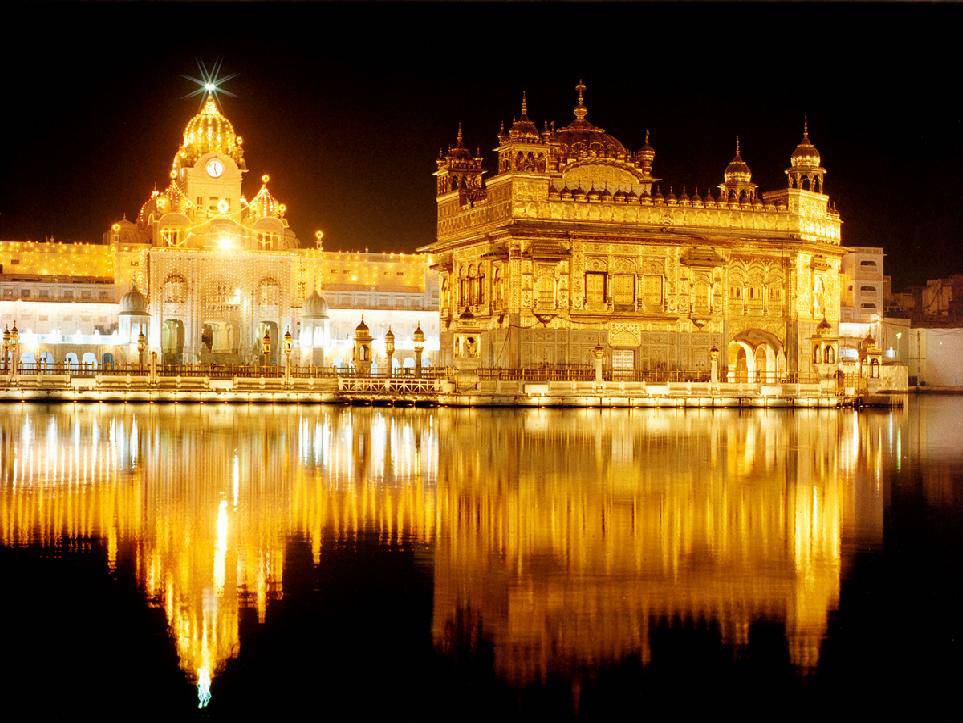Amritsar:

Amritsar is home to the Religious Building important to Sikhs – The Golden Temple. Amritsar is an institution by itself. And the Golden Temple is the cradle of Amritsar with the city growing around it nurtured by its divine sanctity. Amritsar is one of the most sacred sikh religious sites in India.
Golden Temple Amritsar: The most important religious place for Sikhs and also the main attraction of the city. Legend has it that when Guru Ramdas heard about healing powers of Amrit Sarovar, he asked his son to build a temple at the site. The foundation was laid by Guru Ramdas and completed by Guru Arjan Dev Ji. The complex is open for 20 hours from 6 am to 2 am daily. People are expected to cover their head, wash their hands and legs before entering the temple. The intricate marble work in the temple and covering of it with gold was conducted by Maharaja Ranjit Singh.
Wagah Border Amritsar: Wagah border post, about 29 km from Amritsar on the Grand Trunk, has become famous for the ceremonial closing of gates and lowering of flags of India and Pakistan. Over 5000 people converge on the Indian side alone to watch the ceremony known as Beating the Retreat. Wagah is about 29 km from Amritsar in Punjab province. As the Flag Code of India mandates that the national flag shall be flown only from sunrise to sunset, the tricolour is hoisted after sunrise and lowered at sunset. The martial ceremony of lowering the flag has been turned into an entertainment at Wagah. It is a highly stylized patriotic aggression on display that is hard to miss and is carried out with great ceremonial pomp and energy.
The BSF and Pakistan Rangers compete to kick higher, march harder and shout for longer duration in a bid to outdo each other. Guards using their bodies rather than their weapons lay on display carefully choreographed contempt. It is a masterly demonstration of how angry you can get without hitting anyone. The flag lowering ceremony, traditionally, has been a display of mutual hatred by BSF and Pakistan Rangers. Even though the whole routine is choreographed and agreed to by India and Pakistan, the ceremony has often been a cause of contention between both the countries. Guards who participate in the drill are carefully chosen on the basis of height, imposing stature, etc., besides their ability to perform the drill to perfection. Even though more aggressive elements of the routine have been toned down, the ostentatious and theatrical hostility is electrifying. It has become a tradition for people from both sides to converge at the border post to watch the ceremony. The crowd on Indian side is heavy on long weekends and public holidays. India and Pakistan have constructed stands to enable their citizens to watch the spectacle with comfort.
With the numbers increasing, Indian government plans to develop Wagah as a tourist destination. The ceremony lasts for around 45 minutes and is over just before the sunset. The time of the flag lowering ceremony changes depending on the season. Generally, it starts at around 4.15 pm during winter and at around 4:45 pm during summer. Seating arrangements have been made to enable spectators to watch the spectacle comfortably. Seats have been reserved exclusively for women. In the general seating only men are allowed as it tends to get very crowded and congested. VIP seating which is closest to the gates requires special pass.
Jallianwala Bagh Amritsar: Jallianwala Bagh is infamous as the site of one of the most monstrous massacres in human history and a dark event during the Indian independence struggle. Also known as Amritsar massacre, as many as 1100 peaceful protesters were killed when British troops opened fire on April 13, 1919. The brutal murder of thousands added fuel to the fight against the British and raised severe questions about the British intentions to rule India in a humane way. Today, the park has been converted into a memorial who sacrificed their lives.
Maharaja Ranjit Singh Museum Amritsar: Maharaja Ranjit Singh Museum offers insights into the life of the Sikh monarch and is housed in his erstwhile summer palace. The museum displays objects connected to the Maharaja such as paintings, armour, coins and manuscripts. The Parwana by Maharaja Ranjit Singh to Raja of Kapurthala is one of the major attractions of the Museum.
Central Sikh Museum Amritsar: Central Sikh Museum displays the gruesome history of the Sikhs martyred by the Mughals, the British and Operation Bluestar. It was established in 1958 and is home to paintings of Sikh gurus, saints, warriors and prominent leaders. It has has a rich collection of coins, arms, ancient manuscripts and also has an excellent library.
Akal Takht Amritsar: Built on a raised platform by Guru Hargobind to defy the edicts of Emperor Jehangir. Jehangir declared that nobody except the emperor shall occupy a throne of more than three ft; Guru Hargobind built Akal Takht on a platform of 12 ft. However, Akal Takht is built lower than Harmandir Sahib as a mark of respect. Akal Takht, the supreme seat of the Sikhs bore the brunt of the attacks during Operation Blue Star in 1984. However, with donations collected from devotees, it was reconstructed. Ghanta Ghar, the main entrance with the Victorian Clock on top, the Adh-Sath Tirath or the shrine of the 68 holy places, Darshani Deorhi are other important sites inside the complex.
Here is Top Best Places To Visit In North India
Agra:
Delhi:
Varanasi:
Jaipur:
Amritsar:
Udaipur:
Jaisalmer:
Leh Ladakh:
